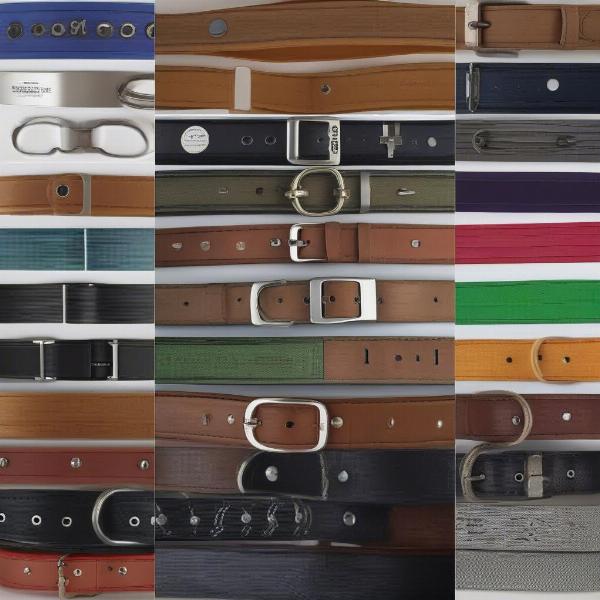Extra large dog collars are essential for large and giant breeds, providing control, safety, and identification. Choosing the right collar involves considering your dog’s size, activity level, and training needs. This comprehensive guide will cover everything you need to know about selecting the perfect extra large dog collar for your furry friend.
Choosing the Right Extra Large Dog Collar
Selecting the right extra large dog collar is crucial for your dog’s comfort and safety. Several factors influence your decision, including material, buckle type, and collar width. Let’s explore the most common types:
- Flat Collars: These are the standard type, ideal for everyday use. They come in various materials like leather, nylon, and biothane. Look for durable materials and sturdy hardware for large breeds.
- Martingale Collars: Designed for dogs who tend to slip their collars, martingales tighten gently when pulled, preventing escape. They’re suitable for training and walking.
- Harnesses: While not technically collars, harnesses provide more control and distribute pressure evenly across the chest, making them a good choice for strong pullers.
- Head Collars/Halters: These fit around the dog’s muzzle, offering greater control over head movement, particularly useful for reactive dogs.
Consider your dog’s specific needs. A flat collar might suffice for a well-trained dog, while a harness or head collar is better suited for a strong or reactive dog.
Sizing and Fitting an Extra Large Dog Collar
Getting the right fit is paramount for your dog’s comfort and safety. A collar that’s too tight can choke your dog, while one that’s too loose can slip off.
- Measure your dog’s neck: Use a flexible measuring tape and wrap it snugly around your dog’s neck where the collar would normally sit. You should be able to fit two fingers comfortably between the tape and your dog’s neck.
- Check the manufacturer’s sizing chart: Sizes can vary between brands, so always refer to the manufacturer’s chart to ensure the correct fit.
- Consider your dog’s coat: If your dog has a thick coat, you may need to adjust the size accordingly.
Materials and Durability
 Comparing Different Collar Materials
Comparing Different Collar Materials
Durability is key when selecting an extra large dog collar. Large breeds exert significant force, especially when pulling or excited. Consider the following materials:
- Leather: Durable, stylish, and comfortable, but requires regular maintenance.
- Nylon: Strong, weather-resistant, and easy to clean, making it a practical choice.
- Biothane: Waterproof, durable, and easy to clean, ideal for active dogs.
- Metal: Strong and long-lasting, but can be heavy and uncomfortable for some dogs.
Extra Large Dog Collar Maintenance and Care
Proper maintenance will prolong your collar’s lifespan and ensure your dog’s comfort. Regularly check the collar for wear and tear, especially if your dog is particularly active. Clean the collar according to the manufacturer’s instructions, considering the material. Leather collars require conditioning to prevent cracking. Collars for extra large dogs (collars for extra large dogs) often experience more stress, so vigilance is key.
Choosing a Collar for Specific Activities
4ft dog leash can be used with different collars depending on the activity. For everyday walks, a flat collar might be suitable. However, for training or controlling a dog on a motorcycle (dog on a motorcycle), a martingale or harness might be a safer option.
Conclusion
Choosing the right extra large dog collar is a crucial decision. Consider your dog’s size, breed, temperament, and activity level. Prioritize durability, comfort, and safety when making your selection. A well-fitted, appropriate collar will ensure your dog’s well-being and allow you to enjoy many happy years together.
FAQ
- How do I know if my dog’s collar is too tight? If you can’t fit two fingers comfortably between the collar and your dog’s neck, it’s too tight.
- What is the best material for an extra large dog collar? Nylon and biothane are excellent choices due to their durability and ease of cleaning.
- Can I use a harness instead of a collar? Yes, harnesses are a great option, especially for dogs who pull.
- How often should I replace my dog’s collar? Replace the collar as soon as you notice any signs of wear and tear.
- What is a martingale collar? A martingale collar tightens gently when pulled, preventing dogs from slipping out.
- Are head collars safe for dogs? Yes, when used correctly, head collars can be a safe and effective training tool.
- Where can I buy extra large dog collars? Pet stores and online retailers offer a wide selection of extra large dog collars.
Related Articles
If available, include links to related articles on your website.
About ILM Dog
ILM Dog is your trusted resource for expert advice on dog care, breeds, health, training, nutrition, grooming, accessories, and more. We are dedicated to providing dog owners worldwide with the information they need to ensure their canine companions thrive. From choosing the right pattern dog coat to finding dog friendly hotels bowness, we cover all aspects of dog ownership. Contact us at [email protected] or +44 20-3965-8624 for personalized guidance.